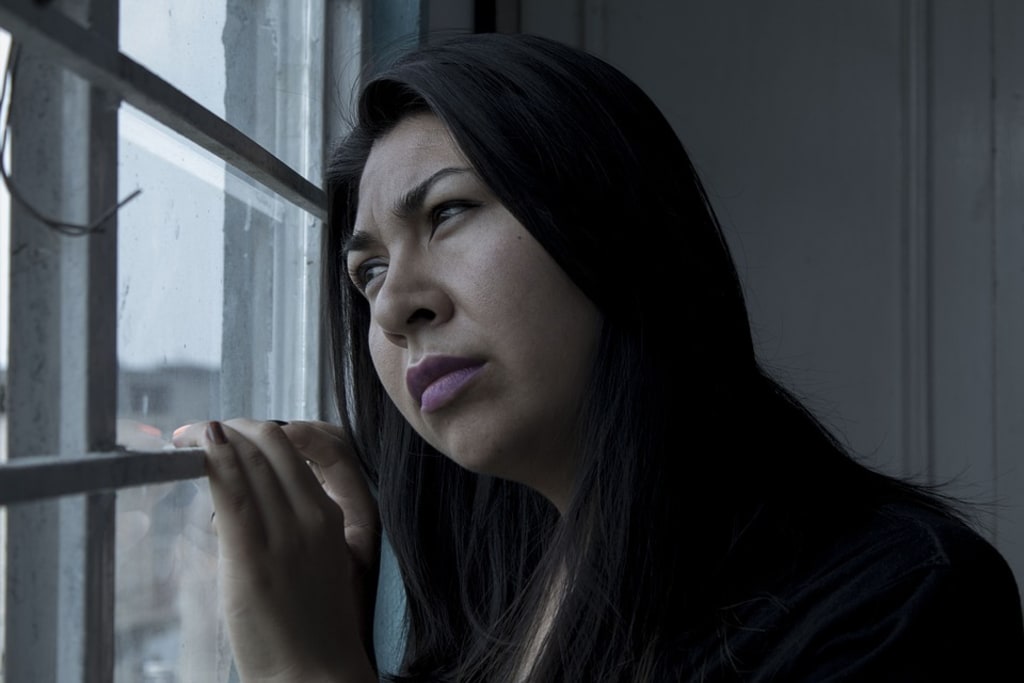Smile, Though Your Heart is Aching
It's Okay NOT to be Okay Story #13 (Depression)

Sometimes the broken parts of you are invisible. They still need attention, and you are not weak for seeking the help you need. (So say I.)
This is the thirteenth piece in a 20-part collaboration that centers around mental health issues in an effort to minimize stigma and start a much-needed conversation.
Disclaimer: "While this piece contains fictional content, the subject matter is very real. People who suffer with mental health issues face not only the struggle of their affliction but the stigma attached to seeking help. It is the goal of this collaboration to destigmatize discussing mental health and instead normalize conversation about it. It IS okay not to be okay." --Courtney Capone
The previous story, by Kyla R., can be found here.
Carolyn:
For as long as I can remember, I have practiced smiling. I would stand in front of the mirror and smile, studying the face in front of me.
My sisters would tease: "Oooh, she's so pretty! Doesn't she think she's pretty?"
"Why, the sun and moon rise on that pretty face! So bee-u-tee-ful!"
"Get lost," I'd say, and laugh good-naturedly. All the while, watching that reflection.
But not because I thought I was pretty. I did not.
I just wanted to make sure it looked REAL.
I wanted to make sure it looked as real as the face I didn't want anyone to see. The face in the mirror behind closed doors, where my sisters couldn't see. The face I couldn't let anyone see.
THAT face said, "Don't look. Don't touch. Don't notice. Don't feel."
Mostly, "Don't feel."
Because feeling was awful.
Mama said, "Pretty is as pretty does. Smile! People want to see a happy, friendly face."
Papa said, "Smile, even when you don't feel like it, and soon enough you will start feeling better. Turn that frown upside down."
Grandpa said, "What on earth do you have to feel sad about? You have everything you could ever want."
I suppose they were all right.
But they were wrong, too.
I smile all day. I laugh. I'm the life of the party, the happiest girl in the room. Ask anyone. I am so happy, happy as a pig in shit.
But mostly, I feel like a girl in shit. I feel ugly and stinky and out-of-place, and I am so damn tired of it all.
When I'm alone, I can't stop crying. And it infuriates me, because I really do have everything I could ever want. I'm not hungry. I'm not homeless. I have enough money, even though I'm not rich or anything.
I even have friends.
But they don't know the real me, and if they did...
Well...
Would they even want to be friends with me?
I doubt it.
I am a façade. I am a cliché.
I’m not real.
God, I’m tired...
Smile. Worst advise I ever got.
Linda:
“She’s not answering, Jake.” Linda hit the end button on her phone and turned to face her boss.
I’m getting worried. It’s not like Carolyn to not show up for work.”
“Especially without calling in first,” Jake agreed. “I guess. She’s never called in before.” Carolyn was his best worker. He frowned. It made him look fierce, but Linda wasn’t fooled. Jake was a giant teddy bear, and she knew he was as worried as she was. “You think she might be sick?”
“She seemed fine last night,” Linda replied. “We had a late dinner and her mom watched Caleb.”
“Why don’t you call her mom?” Jake suggested.
“Good idea.” Linda started scrolling through her phone.

Pam:
When Linda called, I felt a great sinking in my stomach. It wasn’t like Carolyn to miss work. She cared so much about taking good care of Caleb. She worked so hard.
I had kept Caleb overnight, because she called after her dinner with Linda and said she wasn’t feeling well and thought she just needed a night of good, uninterrupted sleep. Caleb still doesn’t sleep through the night, and I sympathized with that, so I agreed to have him sleep over with Nana.
But she wouldn’t oversleep and miss work.
I packed Caleb’s bag and tucked him into his car seat. We drove over to Carolyn’s apartment complex. I kept calling her number, but it would ring and go to voicemail. Finally, it started going straight to voicemail, and I knew her mailbox was full.
By the time I got to her place, I was passing worried and headed for scared.
When she didn’t answer the door, I tried getting in. That was a joke. She’d gotten good locks after the messy breakup with Andy.
Andy…
Had he shown up here? Surely not, but—
I turned and searched the parking lot for his car; it wasn’t there. Caleb grabbed a fistful of my hair and gave it a good yank, but I barely noticed.
I called the police.
**~**
Carolyn:
And here I am—locked in the psyche ward for observation.
Wow.
I can’t do anything right.
We'll return to Carolyn soon, but know this:
For Carolyn, this wasn't the end. It was a new beginning. But that's not always the case.
This story and others like it play out all over the world every day.
• Suicide is defined as death caused by self-directed injurious behavior with intent to die as a result of the behavior.
• A suicide attempt is a non-fatal, self-directed, potentially injurious behavior with intent to die as a result of the behavior. A suicide attempt might not result in injury.
• Suicidal ideation refers to thinking about, considering, or planning suicide.
While there are many factors that may play a part into what led to Carolyn’s situation, depression can be a significant indication that suicidal ideation may occur.
The following video, "I Had A Black Dog", might be helpful to those experiencing symptoms of depression:
What is Depression?
Depression, also known as major depressive disorder, is a mood disorder that can be characterized by the following criteria:
Depressed mood (sadness, tearfulness) for most of the day, every day for at least 2 weeks
Loss of interest in normal activities and relationships
Feelings of hopelessness, worthlessness or guilt
Impaired concentration, including inability to make decisions
Insomnia (not enough sleep) OR
Hypersomnia (too much sleep)
Loss of interest or pleasure in activities previously enjoyed
Feeling restless
Feeling slowed down
Recurring thoughts of death or suicide
Significant weight change (5% loss OR gain within a month)
Appetite changes
Major (or Clinical) Depression, while more severe, can often be of shorter duration than Persistent Chronic Depression (Dysthemia) and may be triggered by
Loss of a loved one (Divorce, relocation, death)
Social Isolation
Major life changes (moving, changing jobs or losing a job)
Personal conflicts
Physical, sexual or emotional abuse
Dysthemia, characterized by 5 or more of the above symptoms and lasting for at least 2 years—or 1 year in teens and children—is a chronic condition, usually more mild than Clinical Depression. However, the condition can accelerate to episodes of Clinical Depression with more severe symptoms if triggered.
There are many other types of depression, including
Paripartum/Postpartum Depression, associated with pregnancy and childbirth
Seasonal Affective Disorder (SAD)
Depression in Teens
Depression in Children
Depression associated with chronic illness
Depression associated with dementia
Any of these types of depression, besides the above symptoms, can manifest the following:
Fatigue
Irritability
Anger
Anxiety
Loss of appetite OR overeating
Muscle aches
Joint aches
Headaches
Stomach cramps or digestive problems
What to do, what to do?
Depression is serious, but it is a treatable condition. With proper care, those with depression can live normal, productive lives.
But the first, most important step is:
SEEK HELP.
Let’s get back to Carolyn for a bit.
Carolyn:
“God, I am so ashamed and embarrassed. What must people be thinking of me?”
She sat in a group of six, including a doctor, who said, “I would imagine they are thinking how lucky they are to still have you in their lives.”
The other group members nodded and murmured affirmative words.
Carolyn stared at them. They didn’t know her. They didn’t know her life. She wanted to scoff at their ignorance, and yet…
They were all here, too.
“How did we get here?” she asked, her voice cracking with despair. “How did it all come to this?”
How DO we get here? What causes depression?
There are no definitive answers to this question. Doctors theorize that the following play a part in the manifestation of depression:
• Brain structure. People with depression seem to have physical differences in their brains from people who don’t have depression.
• Brain chemistry. Chemicals in your brain called neurotransmitters play a part in your mood. When you have depression, it could be because these chemicals aren’t working the way they should.
• Hormones. Your hormone levels change because of pregnancy, postpartum issues, thyroid problems, menopause, or other reasons. That can set off depression symptoms.
• Genetics. Researchers haven’t yet found the genes that might be responsible for depression, but you’re more likely to have depression if someone you’re related to has it.
Source: What Is Depression? | Understanding Sadness and Clinical Depression (webmd.com)
Carolyn:
The police broke into the apartment and found her unresponsive, but they soon determined that she was still breathing on her own. She was tucked into her bed. Various pill bottles surrounded her. The medical response team, which had arrived within moments of the police, took over from there.
Awakening in the hospital was both the lowest point and the highest point of her life.
She’d failed.
She’d survived.
It was time to make a conscious decision about which of those two things to focus on.
“I’m not going to smile if I don’t feel like it,” she told her doctor. “I think I need to be done with that—at least for now.”
“No one feels like smiling all the time,” Dr. Johnson said. “But our social system has made it impossible to feel like it is okay to admit when we aren’t feeling our best. That needs to change.”
“How?”
“It starts with you, Carolyn. You don’t need to think about anyone else.”
“But I’ve let everyone down!”
“Again—you don’t need to think about anyone else. You’re here to focus on you. You’re here to make plans and find a course of treatment that will help you live your life without the level of distress you’ve been dealing with.”
Carolyn sighed and stared over the heads of the others in the room, looking out the big window at the scenic panorama outdoors. “Is it even possible?” she asked.
There was a collective sigh in the room, and everyone looked at Dr. Johnson. She smiled gently and said, “It is.”
Now What?
Step One—Diagnosis
While there are not tests currently to directly diagnose depression, your doctor will start with tests to rule out conditions that may be causing your symptoms, such as hypothyroidism or a hormonal imbalance. This could include blood tests, among other tools.
Once a physical cause has been ruled out, there are other tools for diagnosing different types of depression. You may be referred to a mental health professional.
Step Two—Treatment
A mental health professional can be helpful in diagnosing and treating depression conditions. Treatments can include:
• Medication. Antidepressant medications (in combination with therapy) are effective for most people with depression. There are many types of antidepressants. You may have to try several kinds before you find the one that works best for you. You may need a combination of two. Or your doctor may also prescribe another type of medication to help your antidepressant work best, such as a mood stabilizer, antipsychotic, anti-anxiety medication, or stimulant medication.
• Psychotherapy. Talking to a mental health professional on a regular basis about your depression and other issues can help treat the symptoms. Different methods are available, including cognitive behavioral therapy (CBT) and talk therapy.
• Hospital or residential treatment. If your depression is severe enough that you’re having trouble taking care of yourself or may harm yourself or others, you may need psychiatric treatment in a hospital or residential facility.
• Electroconvulsive therapy (ECT). This brain stimulation therapy passes electric currents through your brain to help your neurotransmitters work better. Typically, you wouldn’t use this therapy unless antidepressants aren’t working, or you can’t take them for other health reasons.
• Transcranial magnetic stimulation (TMS). Your doctor typically suggests this only after antidepressants haven’t worked. This treatment uses a coil to send magnetic pulses through your brain to help stimulate nerve cells that regulate mood.
WebMD, see source link below.
There is no cure for depression. But treatment is very effective. The most important thing to know is, it is okay not to be okay, and it is okay to ASK FOR HELP.
Know your Options:
During these trying times, when getting out can be difficult, it's good to know that there are ways to find help from home. My favorite podcast personality, Michael Rosenbaum, features BetterHelp on his show, and they offer a discount:
Carolyn, Pam and Linda:
“I was so angry at you, Linda,” Carolyn admitted. “But now I’m grateful. Thank you for noticing that I wasn’t at work.”
“It would be hard not to notice,” Linda said. “You never miss work.”
Carolyn sighed. “I just…I guess I never felt like anyone noticed if I was there or not.”
Pam shifted Caleb to her other shoulder. He was still sleeping, and for some reason she was reluctant to put him down. Carolyn seemed content to have him stay with his Nana, at least for now. Pam was having her own issues with guilt over her daughter’s brush with death, but she’d made an appointment for talk therapy and was feeling hopeful about it. “I don’t know how I could have missed this,” she sighed. “How did I not know you were feeling so down?”
“Apparently, I am the best actress ever,” Carolyn replied. “I really believed I could turn my frown upside-down. I did it for years.”
“I do that,” Linda said. “I always think if I do it, I’ll start to feel it.” She took a long, thoughtful look at her best friend. “I don’t think we’re as close as we always believed,” she added. “Neither of us ever talked about it!”
“Well, it’s time we did. What do we have to be ashamed of, anyway? We’re only human. It’s not like it doesn’t happen to anyone else.”
“That’s it,” Pam said. “From now on, honesty is the best policy—even when we don’t like it. I never want anything like this to happen again.”
“I’m so—”
“Don’t say you’re sorry again!” Pam realized she’d spoken quite loudly and in a sharp tone, but she didn’t apologize for it, merely checked to make sure she hadn’t woken the baby. “Being sorry is beside the point. You needn’t be sorry for feeling the way you did—it wasn’t your fault. But—” she added, “Please, please ask for help when you need it. Like you said, what do you have to be ashamed of? People need help sometimes. All people.”
ALL PEOPLE.
Mental health issues of all kinds have been stigmatized in society. If you believe that having a problem makes you weak, remember this—if you fall and break your arm, you seek help without worrying that someone will think poorly of you.
Sometimes the broken parts of you are invisible. They still need attention, and you are not weak for seeking the help you need.
It's okay not to be okay.
Sofia Duarte is up next to tell us about phobias!
About the Creator
Paula Shablo
Daughter. Sister. Mother. Grandma. Author. Artist. Caregiver. Musician. Geek.
(Order fluctuates.)
Follow my blog at http://paulashablo.com
Follow my Author page at https://www.amazon.com/Paula-Shablo/e/B01H2HJBHQ
Reader insights
Outstanding
Excellent work. Looking forward to reading more!
Top insights
Excellent storytelling
Original narrative & well developed characters
Expert insights and opinions
Arguments were carefully researched and presented
On-point and relevant
Writing reflected the title & theme
Easy to read and follow
Well-structured & engaging content
Eye opening
Niche topic & fresh perspectives
Heartfelt and relatable
The story invoked strong personal emotions






Comments
There are no comments for this story
Be the first to respond and start the conversation.